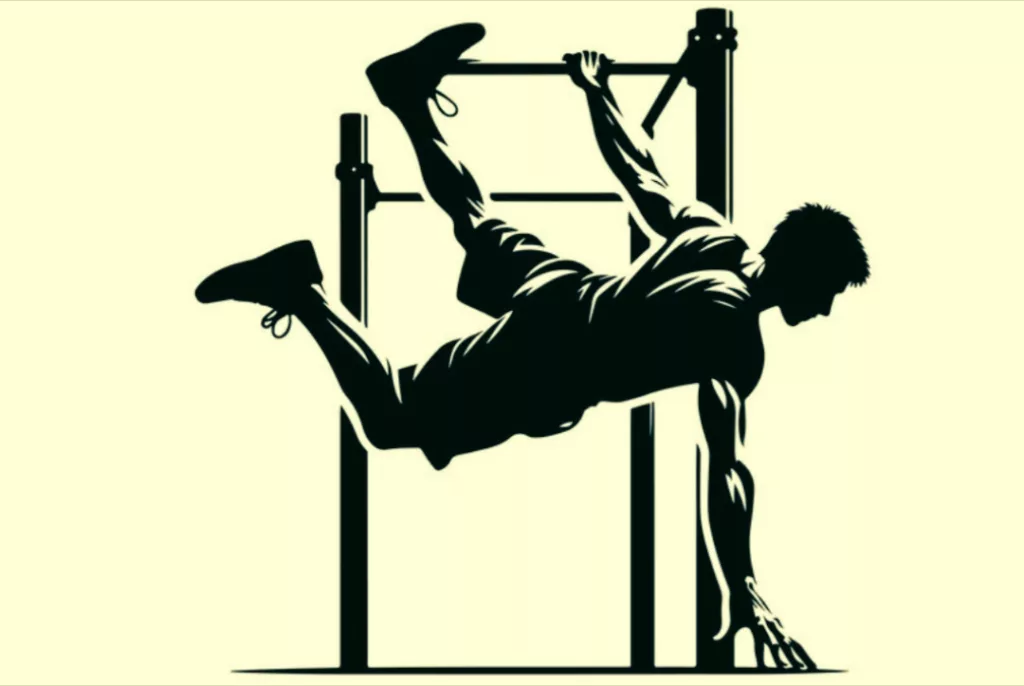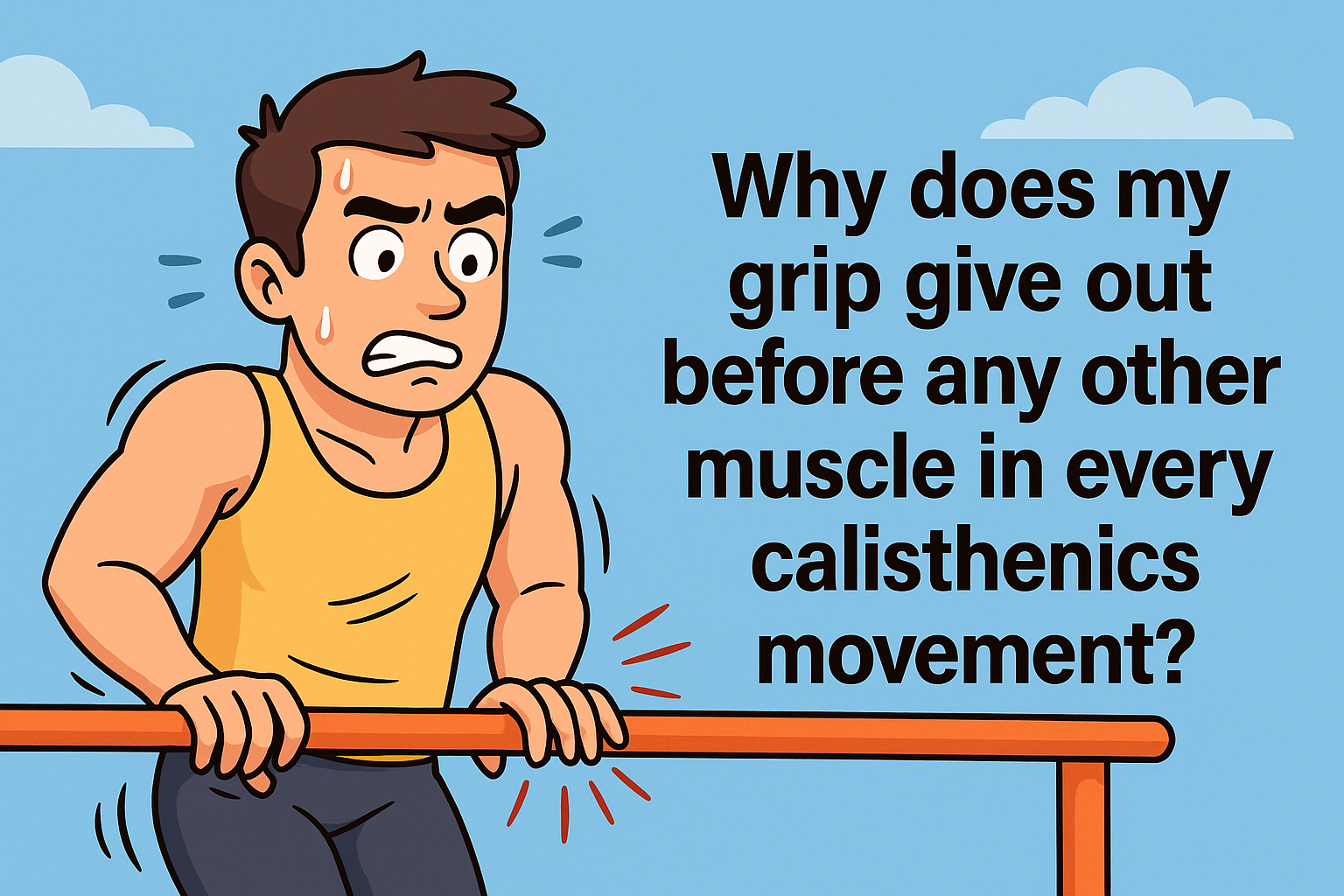We’ve all been there
You’re fired up like a spring, ready for your calisthenics workout with the spirit of a parkour ninja.
You grab the bar thinking: “Today’s the day I destroy my lats.”
And yet…
Halfway through your first set of pull-ups, your hands start to slip, your fingers bloom open like spring petals, and you feel that annoying tingle in your forearms.
But your shoulders still feel fine.
Your back? Not even warmed up.
Your core? Fresh as a mojito.
And yet you have to quit.
Why? Because your grip is the first system to fail—long before your main muscles get a chance to speak.
And the frustration? Oh, it hits hard.
| Weak grip = slow progress everywhere else
A weak grip isn’t just annoying. It’s a bottleneck for everything else. Want to master the front lever? You need grip. Until you fix this piece, expecting miracles is pointless. |
Grip is the weak link in the chain—but it doesn’t have to stay that way
The human body is a masterpiece of biomechanics, no doubt.
But like every work of art, it has its weak points.
Grip is one of them.
It’s literally your first point of contact with the outside world.
The bridge between you and the bar.
Between you and your own bodyweight.
And when that link fails, the entire chain breaks.
The problem?
Almost no one trains their grip intentionally.
People focus on lats, shoulders, biceps, abs… but grip?
It’s just expected to keep up.
Until you’re stuck mid–front lever, and your hands feel like soggy sausages that can’t hold anything.
Calisthenics is cruel to your grip (and it’s on purpose)

Here’s the truth: calisthenics is brutal. It gives you zero shortcuts.
In the gym, you’ve got wrist straps, hooks, knurled handles, leather gloves with Batman logos.
But if you’re under a bar at a playground at 7 a.m., none of that is there.
Just you, your bodyweight, and a bar colder than your ex’s heart.
And every move demands a firm grip:
- Wide grip pull-ups
- Front lever
- Skin the cat
- Tuck hold on rings
- Muscle-up (especially the initial phase)
All of these movements require one specific thing: isometric grip endurance.
Meaning: holding something tight without dynamic movement, keeping the tension constant.
That’s where most people fall apart.
It won’t improve on its own. Ever. You have to train it.
Here comes the harsh truth: If you don’t train grip specifically, it’s not going to get better.
Doing more pull-ups and hoping your grip will “eventually” catch up is like thinking cooking every day will automatically make you a Michelin-starred chef.
Spoiler: it won’t.
You need targeted work.
And I’m not talking about 5 kg forearm curls.
I’m talking about:
- Extended dead hangs
- Heavy farmer carries
- Pinch grip (holding plates only with your fingers)
- Towel pull-ups
- Climbing grip squeezes
- Sand or rice bucket drills for fingers and wrists
And you need to treat these like weekly essentials—because they are.
The warning signs that your grip is sabotaging your progress
Not sure if grip is your main issue?
Here are some red flags:
- You can only do a few reps, but your forearms are burning before any other muscle
- You can’t hold static ring positions, even with a strong core
- You literally slip off the bar after 10–15 seconds
- You feel constant pain between wrist and elbow after training
- You find yourself shaking out your hands between sets like you touched a hot pan
All signs that your grip system isn’t matching your muscle goals.
A weekly grip routine that actually makes a difference

You don’t need hours. You need intention and consistency.
Here’s a sample protocol to do 3 times per week (maybe at the end of your session):
🟡 Dead hang – 4 sets to max time (1’ rest between sets)
👉 Hang from a pull-up bar with arms fully extended and shoulder engaged. Don’t swing. Just survive.
🟡 Farmer carry – 3 sets of 30–45 seconds with heavy dumbbells or objects
👉 Grab the heaviest weights you can hold and walk in a straight line. Keep your core tight and shoulders pulled back.
🟡 Pinch grip with plates – 3 sets of 20 seconds
👉 Hold two smooth weight plates together (flat sides out) just with your fingers and thumb. No handles, no cheating.
🟡 Towel pull-up or static hold – 2–3 sets of 10–20 seconds
👉 Hang from a towel looped over a bar (or do pull-ups with it). Your forearms will scream—don’t let go.
🟡 Final finger and forearm stretching
👉 Stretch each finger back gently, then stretch your wrists and forearms with palms up and down.
👉 After 2 weeks, you’ll feel a difference.
👉 After a month, your hands will feel like those of a Ukrainian bricklayer.
📅 How often should you train grip and forearms each week?
The ideal frequency depends on two things:
- Your experience level
- How often you already use your grip in other exercises
If you’re a beginner or your grip is weak, 2–3 sessions per week are perfect. Focus on quality, not volume.
If you’re intermediate or consistently doing calisthenics, go up to 4 sessions per week, but vary the intensity:
- Two intense sessions (long dead hangs, heavy carries)
- One or two “light” maintenance or mobility sessions (stretching, short holds, light isometric work)
⚠️ Important: Don’t train grip heavy two days in a row. Give it at least 24–48 hours to recover, especially if you feel forearm tension or wrist stiffness.
💡 Tip: Add mini grip sessions even outside your workouts. For example:
- While waiting for pasta water to boil, do pinch grips with a jar of tomato sauce
- Hang an old towel on a door and try to hold it for 20 seconds a day
These tiny moments add up.
Related: watch out for overgrip inflammation
One last note that often gets ignored: training grip too much, too soon, can lead to annoying issues.
- Tennis elbow (lateral epicondylitis)
- Wrist flexor pain
- Constant forearm tightness
The secret is progression. Just like everything else.
Don’t go from zero to one-minute weighted dead hangs overnight. Build it up. One day at a time.
🧠 How grip affects coordination and motor control
It’s not just about brute strength.
A stronger grip improves proprioception—your body’s ability to sense its position in space.
Ever wonder why you seem clumsy on the rings, even with a solid strength base?
Often, the issue isn’t in the “big” muscles—but in the lack of sensory feedback from your hands.
The more your brain trusts your fingers, the better you can coordinate full-body movements.
That’s why many athletes notice that as soon as their grip improves, they can hold front or back lever positions with much more stability.
It’s like the entire body turns into one unified block.
🧤 Gloves, chalk, wrist wraps… do they help or hurt?
Hot question: are external supports helpful or counterproductive?
The answer is: it depends.
👉 Chalk helps prevent slipping and increases time under tension—but doesn’t make your grip stronger.
👉 Gloves protect your calluses—but reduce tactile sensitivity. And sensitivity is crucial for motor control.
👉 Wrist wraps or hooks reduce forearm activation—great for powerlifting, not so great for calisthenics.
The advice: Use these tools as temporary aids, maybe when focusing on technique or advanced movements.
But don’t rely on them every time.
If you want a strong grip, you need raw friction, direct contact, rough textures.
📈 How to track grip gains over time (without going crazy)
Common mistake: training grip “by feel” without any idea of progress.
Here are three simple but powerful indicators to track:
- Max dead hang time (same grip style, weekly stopwatch check)
- Farmer carry duration with fixed weight
- Number of towel pull-up reps
If you see even small improvements every 7–10 days, you’re on the right track.
If you’re plateauing for 2 weeks straight, change the stimulus: increase grip thickness, adjust the angle, or reduce rest time.
👉 Grip responds well to variety—but hates boredom.
🥶 What to do if your forearms hurt but you don’t want to stop training
Chronic forearm discomfort is super common, especially for calisthenics newbies who go too hard too soon.
But stopping all training isn’t always necessary.
Try these tweaks:
- Change grip angle (switch from bar to parallel bars or rings)
- Alternate isometric holds with dynamic work
- Add active stretching and wrist mobility at the end of sessions
- Reduce volume for a week, but keep the frequency
👉 Don’t ignore pain. But don’t treat it like a permanent sentence either.
Often, small adjustments are enough to keep making progress without making things worse.
RELATED:》》》 Stronger Grip, No Gym Required: Try These 4 Simple Moves
Conclusion
When your grip gives out, it’s frustrating.
But it’s also a signal. An opportunity to fix something you’ve always overlooked.
If your strength never gets fully expressed because of your hands, you’re not weak—you’re incomplete.
And the good news is, you can fix it. Even in a few weeks.
Just start.
And once your grip is solid, the rest of your body will follow. More reps. Less frustration. More control. More confidence.
Because when you feel like you can hold on to anything, everything gets easier.
Even motivation. Even fatigue. Even pain.
💪 Train your grip. It’ll never be wasted time. It’ll be the turning point you were missing.

